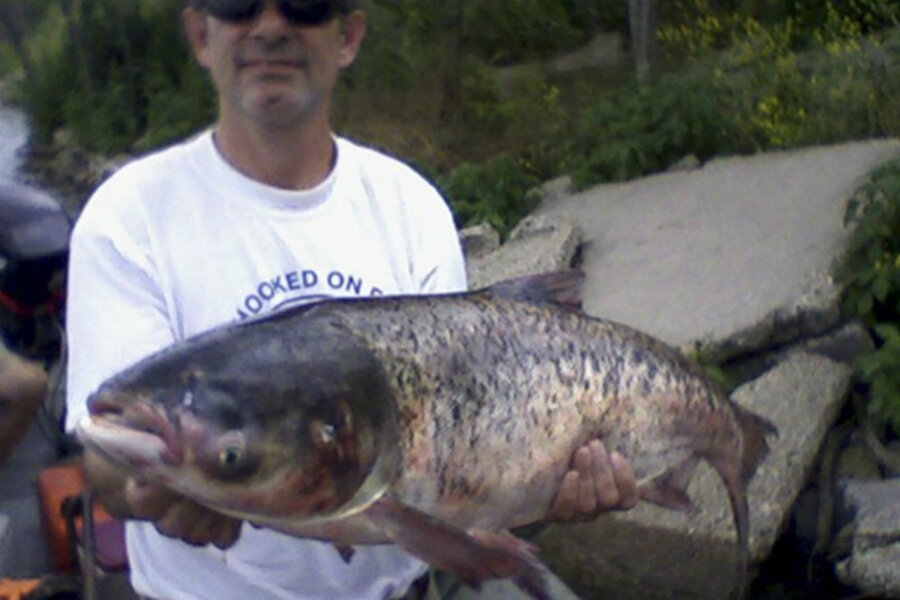Senators raise alarm over Asian carp invasion in Great Lakes
Loading...
A coalition of US senators from the Midwest are asking the US Army Corps of Engineers to speed up finding solutions to avert an Asian carp invasion of the Great Lakes that they worry is imminent.
What's driving the urgency, detailed in a letter sent Thursday, is the discovery of Asian carp environmental DNA, or eDNA, in Lake Michigan, near Wisconsin's peninsula. The sample, discovered by researchers from the University of Notre Dame and The Nature Conservancy, along with state officials, was a result of research conducted in May, outside the Sturgeon Bay shoreline, and reported this week.
It's the first time evidence of the invasive species was found outside the electric barrier in the Chicago Sanitary and Ship Canal designed to prevent the fish from entering the Great Lakes. Asian Carp, which reproduce quickly and can weigh as much as 100 pounds, threaten tourism and a $7 billion fishing industry, state and local officials say.
The letter, signed by 16 US senators from both parties, asks the agency to identify a solution “that will maintain commerce, enhance and not degrade water quality, and permanently safeguard the Great Lakes from Asian carp and other invasive species." It also calls on Washington to “identify interim measures that can be put into place to greatly reduce the risk of invasive species moving between the Great Lakes and the Mississippi River basins.”
“It is imperative that the Corps continue its evaluation process under existing authority so that we can move very quickly on a comprehensive approach to best protect the environmental and economic health” of both water sources, the letter reads.
The Obama administration promised expediency on the issue and has spent about $200 million so far on measures to shield the lakewaters from the carp. Five years ago, the US Army Corps was ordered to speed up a feasibility study, due in January, that will provide alternatives to mitigating the problem, but the senators say the report is not enough. They say the report also needs specific recommendations from the corps that detail next steps in eradicating the problem.
Tim Eder, executive director of the Great Lakes Commission, an organization in Ann Arbor, Mich., that studies conservation of the Great Lakes basin and St. Lawrence River, says the letter expresses the frustrations many political leaders located in the Great Lakes region have regarding the carp. “The pace does not sync up with the urgency of the situation,” Mr. Eder says. “There’s a real hunger for early action.”
Critics of eDNA say it is an unreliable method to fully determine the presence of a species. A recent US Army Corps report said that evidence of the carp near waterways connecting to the Great Lakes could be linked to third-party transport, via a bird or human, and not the presence of a live fish. Before the discovery this month, 58 water samples testing positive for eDNA of Asian carp were found primarily in both Lake Erie and the Chicago waterway system.
Mike Staggs, the fisher director of the Wisconsin Department of Natural Resources, urged that argument this week in comments made to the Green Bay Press Advocate. Mr. Staggs said he was “skeptical” that the eDNA samples” suggested the presence of a carp invasion.
“I’ve seen pelicans eating carp on the Illinois River. May is the time of the year when birds migrate north,” he said.
The state Department of Natural Resources has asked the state Fish and Wildlife Department to conduct a second series of tests; results are expected in January.
The May testing included 50 water samples taken from the Green Bay area; they were among 282 from other areas along Lake Michigan. Last week, eDNA evidence found evidence of four grass carp, a less worrisome species of carp, in Ohio’s Sandusky River, which is a tributary of Lake Erie.
Even though grass carp are not as threatening, scientists say their presence is alarming because the conditions they require to produce are identical to those of the bighead or silver carp, which are more destructive.
Duane Chapman, a fisheries biologist with the US Geological Survey and a member of the Ohio research team, said that the discovery in the Sandusky River was “bad news” and “means that many more reservoirs in the United States are at risk of Asian carp establishment,” he told the Associated Press.
Environmentalists and some political leaders are calling for a permanent barrier between the Great Lakes and Mississippi River watersheds. Eder says that before that protection is in place, which would cost millions and take years, there needs to be “immediate short-term steps” taken to slow down the invasion.







